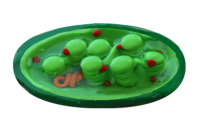11th grade
Symbiogenesis
Activities:
-
Learn why phagocytosis was the key feature that made symbiogenesis possible in eukaryotes
-
Explore a timeline from an ancestral eukaryote without mitochondria or chloroplasts to modern plants and animals
-
Sort arguments for and against symbiogenesis into the correct categories
-
Reflect on why some plastids have three or four membranes and why different chloroplasts resemble different cyanobacteria
-
Compare the structures of mitochondria and chloroplasts, clicking on their shared features
-
Investigate other proposed cases of symbiogenesis—such as flagella, peroxisomes, nuclei, or microsymbionts in Pelomyxa, Paulinella, and Mixotricha paradoxa—and work out which ideas are supported by evidence and which remain speculative
-
Decide what in the eukaryotic cell is a true cellular structure—and what was once a separate organism
Parts of Flowering Plants
Activities:
-
Sort plants into their main divisions (mosses, ferns, gymnosperms, angiosperms, etc.)
-
Study the structure of a flower and decode its floral formula
-
Learn to distinguish racemose and cymose inflorescences and sort examples
-
Compare simple and compound inflorescences and match them to real flowers
-
Apply critical thinking to identify real-life examples of abstract inflorescence diagrams
-
Explore fruit diversity—including aggregate, multiple, and false fruits—and sort them into groups
-
Examine leaves and stems of nearby plants, identifying their key features like venation, margins, and arrangements

